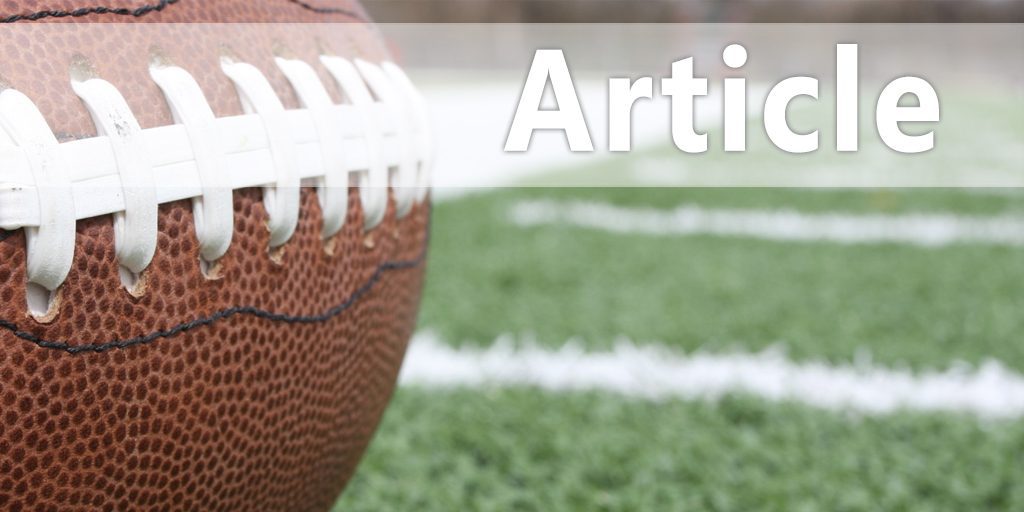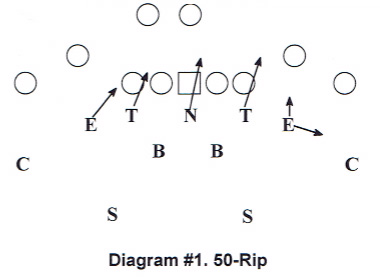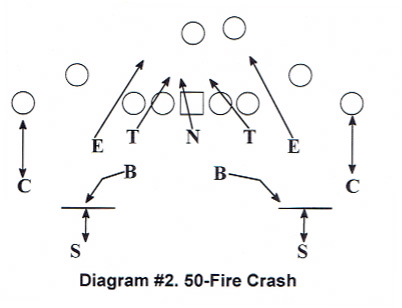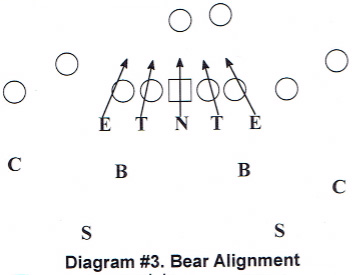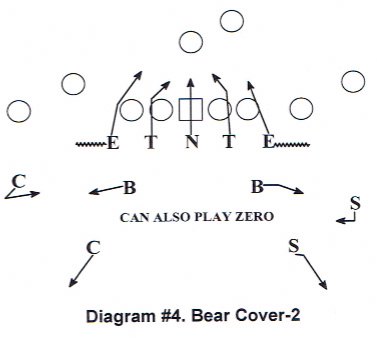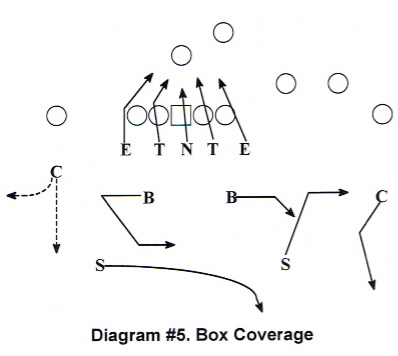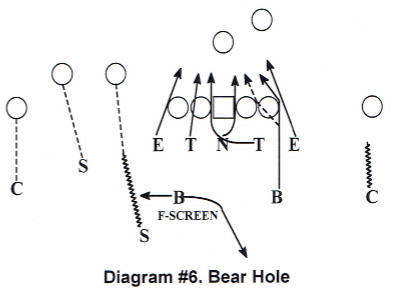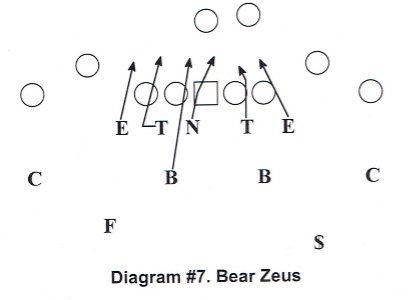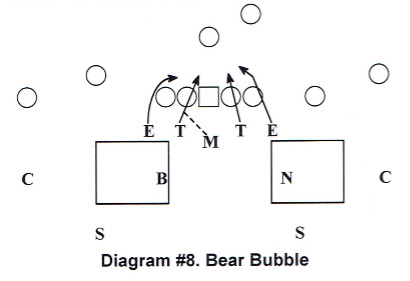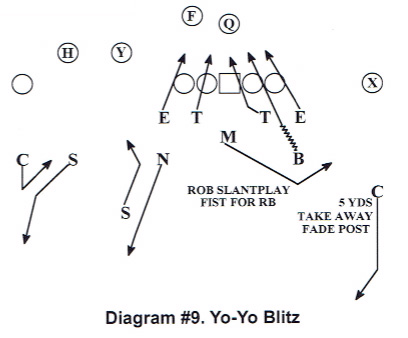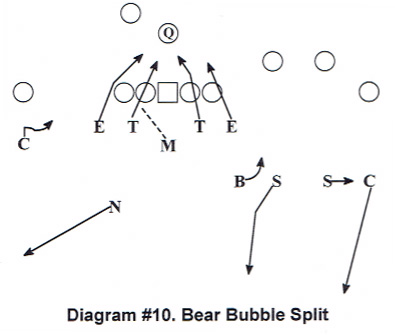| Strategies on 3rd Down with the Bear Defense |
| By: Chris Silvestri - New Canaan High School (CT)
Originally Published in: Nike 2016 Coach of the Year Clinic Notes - by Earl Browning Provided by: Nike Coach of the Year We use the Bear strategies with the nickel package. Most people think about third down and getting off the field as third and eight. From my experience, that is not always the case. It is third and four or five where you need the stop to get off the field. We want to play the best defense to give us that stop and get us off the field. That is what this presentation will be about. I am going to show you a couple of different fronts and blitzes. I am going to talk about our practices and how our personnel fits into that. For a while New Canaan High School had some of the smallest inside linebackers. They were tough and could read the entire offense. A couple of years ago we had two linebackers that were maniacs on the field. You did not need to call a defense. The problem is we do not have those types of players any more. This is not the University of New Canaan. We are a high school team. Sometimes you are lucky to have great linebackers and sometimes you do not. I am going to talk about why we went to the Bear defense. How we put pressure on the offense and get man-to-man matchups up front. I want to talk about the philosophy behind our defense and what we call it. Everyone has a job on our defense. Based upon where a person does his job depends on helping his brother out. We call that HYBO. I am an acronym maniac. I will throw acronyms at you but I will tell you what they are. We are not a big believer in helmet stickers. I give helmet stickers for someone doing his job and enabling someone behind him to make a play. I give them stickers in games and in practice. That is what we want to reward. If a defensive back makes a big mistake, the player that tries to pick him up and make him feel better is helping your brother out. Why Bear Defense • It fits well with a 50-front without teaching new technique • Forces 1-on-1 matchups and we can send or cover with 5 or 6 • Linebackers are freed up (Hot areas) • Coverage can remain similar for defensive back • Opens up twist blitz packages • Allows us to attack protection schemes We are a 50's defense. This came way before I did. I had some great mentors. My head coach was a defensive mastermind. Even today he is constantly sending me information of what to do. All these guys taught me how to use these fronts and how to attack the offense's pass protection schemes. Pass protection is huge when it comes to the Bear front. When you play the Bear front you do not need to teach anything new in the defensive line as far as technique. The only thing it changes is our linebacker reads. They do not read guards and fullbacks. We do not do that as much in this front. The Bear front forces one-on-one matchups with offensive linemen. There will be five-on-five blocking. Hopefully we will have one defender better than one of their blockers. The linebackers are freed up. We can pop them right into the hot areas. Our coverages can remain the same for the most part. We are a 2-read team and we play a couple of spot drop coverages. All those coverages stay in the Bear scheme. The Bear front opens up some good games, blitzes, and stunt. From this front you can attack the pass protection scheme of the offense. With this front we have seven defenders in the box with two overhang players. We do have similar responsibilities as far as the linebackers go. Our linebackers are A to D-gap linebackers. Everything will collapse in front of them and they are sitting there waiting patiently for something to happen. From day one our defense works on spread offenses. They work 2 X 2 and 3 X 1 formations with a shotgun quarterback. What we are trying to do is protect against the hot routes. That is what they refer to as the uncovered wide receiver. Issues to Overcome (ITO's) • Gives linebackers different reads no longer single gap responsibility • Can increase chances of home run play • Tougher to disguise man-to-man coverage This defensive front has issues you must deal with. Playing this front can increase the chance of someone throwing the home run ball. Third and long, the Bear front my not be the best call. However, for the third and medium to short calls it fits perfectly. We generally align our safeties at 10 yards. If you are playing 0-man coverage. it is hard to disguise that. The safeties have to drop down quickly to defend in man-coverage. This is our philosophy on this defense. This is huge and all we do. Everyone Must Tackle • Tackling/strip circuit • Turnover Tuesday • Whistle strip • Shimmy-shimmy - pop • Form tackle with strip • Badger hands • Block shedding Player centered language - Player will understand concepts and players will name the call/coverage/blitz I try to get safeties who are linebackers. They must keep everything in front of them. (KEIF) They are downhill players. They have keys they read and play downhill. They must be able to tackle in open space and be a part of team tackling. They must know if they are an alley defender playing inside/out or a force defender playing outside/in. All of that is taught. We have "Turnover Tuesday." That is a big piece of our Tuesday practice. In every drill we do we are constantly ripping at the ball. We do "whistle strips." We strip the ball before the whistle and after the whistle. That is one thing our players have become good at. They became good because we practice it. In our game schedule last year, we played Windsor High School on a Tuesday. Our players were fired up because it was turnover Tuesday. It does not stop in practice: it carries over to the games. When we tackle we want to tackle with our feet. We want the feet in proportion with our body. We want the chin over the toes and we want to make sure we have that balance. When you do form tackling, we teach strip tackling. Getting off blocks is huge to a defensive football team. We teach arm extension, punch, hand placement. and how to play with your hands. That is part of our tackling drills. It does not need to be an Oklahoma drill. It can be a simple one-on-one drill. Make sure your players are competing. Keep score when you play against opposing positions in practice. Our players want to name everything. They want to name our blitzes. We allow them to do that. Our reasoning is if they want to name it they have to know it. I do not know how many times I have argued with a player about him not knowing the stunt. He called it and named it so he better be able to play it. That is the education part of letting them name the blitzes and parts of the scheme. They named the blitzes that went with our cover-4 using dogs' names. When we called the same blitz from a Cover-3 by the same dog names except the name was in Spanish. That way they knew Cover-4 from Cover-3. It worked because when the Spanish dog came up they knew that was Cover-3. Do your job • Tackle with feet • Fly to ball • Control your gap • Do your discipline ° Leverage ° Drills to film ° Play low, hard, and fast ° Movement When you do your job, good things happen. We are a single gap team for the most part. However, we had a nose guard this year that is going to TCU. We let him two gap. He played both the A-gaps. We put him on the center and his job was to control both those gaps. He was fast and strong. That becomes a pain in the butt for any center. I want to see the drills we do in practice in the games. Never do a drill to be doing a drill. All your drills should be game related. I want see to the drills in the film. Our motto for the defensive line is play low, hard, and fast. In the last five years, if you ask any of our defensive linemen how they play, they will tell you low, hard and fast. That is what we are trying to get them to do. HYBO (Help Your Brother Out) Up front - Defensive line (Heartbeats) • Do not left offensive linemen get to second level • Collapse double teams • Hands on read • Stay midline, (when unblocked occupy the 1 X 1 area in front of the quarterback) • Play excited • Pick up your teammate • Congratulate your teammate Do your job does not mean you make the play. You do your job so somebody else can make a play. That is a huge thing for us. I talked about how we reward that type of play. Up front we call them the heartbeats. When we are in a technique, we need to get our hands on the offensive blocker we are reading. We have a gap we must control, but we have a discipline we must use. Staying on the midline when unblocked helps us with some of the power read scheme. We are looking for the trap. If it does not come stay there and do not chase, unless you are chasing a pulling guard. Playing excited and thinking about your teammates is important in teamwork. It is simple stuff but it has to be reinforced all the time. If you want your defense to be good, play excited, pick up your teammate, and congratulate him. Second Level • Know the call • Pre-snap assignment • Movement ° Stemming ° Disguise coverage We can align in a four-man front and stem it back to the 50-front. We want to give the offensive line something to think about. I would encourage all you to practice stemming. If you move right before they snap the ball, all of a sudden the tackle has a free shot on the running back. The offensive line communication breaks down. If you have offensive line calls. stemming is a killer for that. It does work and it gets our players in position to make plays. Our base front is a 50-angle front. We are angling away from the strong safety. Everybody should know everybody's job whether you are a linebacker, end, or secondary player. If I put my strong safety as a corner, he should know how to play corner. The defensive tackles play left and right tackles. They do not flip/flop. The linebacker is a linebacker. We are B. T, N, S, and C. There is no flip/flopping. I want them to know what they are supposed to do, what their pre-snap gap responsibility is, and go play football. What we have here is a pre-snap gap responsibility called "50-Rip." (Diagram #1) We are going to angle away from the running back's alignment. The left tackle becomes a veer tackle and is responsible for the B-gap. The left end is the D-gap defender. The nose is the A-gap defender. The right tackle at times stunts and at other times plays straight. The right end is the extra player and can drop into the secondary.
In the secondary, we can play quarter-quarter-half coverage because we have an extra secondary player (right end). We could play "Cover-2 Read." We are reading off the number-2 receiver. Everybody has a pre-snap gap responsibility based on that one call. The linebacker to the side of the back is an A-gap play. He is a patient player into that gap. The backer away from the running back has the B-gap and is a fast player. We do that because the number one play we see is the zone and zone read. The A-gap linebacker wants to play slow and wait for the wing back. The slow linebacker will be unblocked because of the angle of the left tackle. He reads and lets the ball come back to him. This next defense is the old Michigan defense Bo Schembechler ran. The call is -50-Fire Crash." (Diagram #2) On this call we send the nose weak, which is away from the running back. Both ends are crashing off the edges. Both tackles veer inside into the B-gaps. The only gap we have open is the strong A-gap. If everyone has a single gap responsibility. This is the making of the Bear defense.
In the Bear. the tackles align in the B-gap instead of slanting into it. (Diagram #3) We align the tackles in a tilted 3-technique, which looks to the offensive guard that he is going to pinch. However, the tackle is coming right at him. I want the tackle to get the guard's attention.
The nose guard is a two gap player. The interior collapses on itself really quick. The ends are coming inside off the edge. They are keying the block of the tackle. If he blocks down, the end wants to vacuum the line of scrimmage. Usually one of the ends will be more dynamic than the other. He gets around the offensive tackle if he tries to pass block him. The linebackers align head up on the tackles at six yards. l want them to play downhill and cover from A-gap to the D-gap. I believe the tackles, ends, and nose will collapse the middle and leave the linebackers unblocked to make tackles. In the secondary we can play Cover-2, man-coverage, or 2-read. Nothing really changes for the secondary. By putting the linebackers wide at six yards they are in an automatic hot read on the number-2 receiver. At the defensive ends we look for tall lanky personnel. We want them to create a vision problem for the quarterback when they put their hands up. They must be athletes and are allowed free range. but not freelance. They can align wherever they want, but they have to be in that vacuum at the line of scrimmage when they snap the ball. We want the quarterback to wonder what is going on with the defensive ends. We do not want them getting too narrow on their charge because that can lead them upfield. We can play Cover-2 versus the Ace formation. (Diagram #4) The corners are rerouting the outside receiver to the inside. The safeties are playing down the hash and the inside linebackers are hook/curl droppers. We can play the Cover-2 read and Cover-0.
We have a box coverage we play into the trips formation. (Diagram #5) On this coverage the corner and strong safety switch responsibilities. The corner goes to the deep quarter of the field. The strong safety rolls down into the flat area. He is going to rob the pattern of the number-2 receiver in the trips set. The free safety is reading the number-3 receiver in the trips set and has coverage on him if he goes vertical.
1 prefer to roll the corner instead of dropping the safety down. The corner has the field in front of him and can see the patterns of all three receivers. The safety when he inverts has trouble seeing things going on to the inside. He is trying to get to the flat area and loses some of the receivers. Our linebackers started out shaky and ended up playing great for us. The thing they must do is keep their depth and not get too hyped up. They must play under control and not get too tight to the line of scrimmage. If they get too tight they get washed to the inside. They can really help us in a trips formation. As long as they keep their depth. they do not need to widen much to be in the middle of all the hot reads. In our box coverage in the trips set, teams were beginning to keep the running back in to block, and then releasing him as the safety valve. The offense felt they always had an open man to throw to if the protection broke down. The linebacker to that side has to be aware they can swing the back and he should be able to play him. In the 2 X 2 set, the defensive end is aligned in a one-by-five alignment on the number-2 receiver. He shimmies to the inside and comes down the line of scrimmage reading the tackle. Our split rule adjusts to the width of the receiver. The wider he gets the more inside we get, and deeper we align. In the Bear. we want the defensive end to time his movement and attack as the ball is snapped. When he comes from width, he can see the tackle blocking down and he should see the pulling guard or running back coming to block him. If the defensive end creates a seam with his charge. the linebacker is sitting to the inside and closes the seam. When he attacks from width, he can determine if the quarterback is retreating or stepping up. That gives him a two-way-go on the blocker. If the quarterback is stepping up, he can go inside the blocker. If he sees the quarterback still retreating. he goes outside the block. This next item is what we call "Bear-hole." (Diagram #6) This allows us to run some twist stunts with the interior linemen. This stunt depends on the personnel you play in your defensive line. This year we had big linemen and it was not quite as good as it has been in the past. They were not as fast and their technique was pretty bad. They played too high to run the twist.
We must add a "to" or "away" to designate the tackle that is twisting inside. In the diagram. we are twisting the tackle aligned to the running back. The nose guard comes into the strong side A-gap and the tackle twists to the weak side A-gap. The nose guard must stay on the track. He cannot get washed down the line of scrimmage. If he feels himself being washed, he collapses and creates a pile. The end to that side comes off the edge as an edge rusher. The linebacker to that side blitzes. He puts the tackle in a conflict. If the tackle turns outside to block the defensive end. the linebacker blows the B-gap. If the tackle takes on the linebacker. the defensive end is unblocked to the running back. We play Cover-0 in the secondary. Everyone locks up on a receiver with no middle of the field help. We have one linebacker left that can spy on the quarterback for draw, the fullback for the screen. or help in general coverage. All that comes from tendencies and game plans. You can get some great plays from the looping tackle into places they do not expect to see him. The running back sees the open A-gap and when he commits to run there. he is blown up by the tackle twisting into that gap. If the guard attempts to follow the twisting tackle that opens up two gaps. The twist confuses and messes up the protection scheme. The place you should break free is the linebacker blitz on the tackle. Either way the tackle goes, he loses. If the tackle blocks the end. the linebacker is free. If he takes the linebacker the end is free. We have another blitz we call "Bear-Zeus." (Diagram #7) The nose guard gets into a tilted stance to the weakside away from the running back. This is another opportunity to blitz the A-gap. The weakside tackle slants to the outside into the face of the offensive tackle. The defensive end comes off the edge. The weakside linebacker blitzes over the offensive guard. The nose attacks the center and works to the front side.
The tackle to the weakside is in conflict with the 3-technique tackle in his face and the defensive end coming off the edge. The defensive tackle charges outside hoping the guard follows him to the outside. The linebacker is to his inside. 3rd Down Get Off the Field Strategies Things to think about? • 3rd down distance • Offensive tendency • Tip off what we Give and what we take Away (why) I showed you the Bear front will work on any down. You may not want to run the defense on third and twelve, but from third and 8 on down it is a viable front to be in. I love it. When we get into third down, we look at the distance for the first down and what the offense has a tendency of doing in that situation. We do not want to tip off to the offense as to what we are giving up and what we are taking away. I want the quarterback to go through his progressions and find out we are giving him a three yard out pattern. The secret is this. The quarterback is not going to know what we are running until he snaps the ball. Practice 3rd Down Tendencies • Know the offensive tendencies through film breakdown • Know the N.A.P. player (Need A Play) • Stem in and out of fronts (day 1 practice) • Have "lab" period in practice • Bringing the offense to 4th down is a win Many times in this situation. the quarterback is the NAP player. We will do everything in our power to put our players into a position to stop that player. He could be anywhere in the offense. but you must identify and stop him. That is how we are going to practice. Our kids know who the NAP player is. This next point is huge. We have a "lab" period in practice. We practice the two-minute drill by giving the offense the ball at the one-yard line and tell them they have two minutes to score. That is in your offensive period. when you are fine tuned in the season. We do the same thing in the defensive "lab" period. We do not want to work against backups and 2nd and 3rd players. If I want to try something new it goes in during the "lab" period. That is where some of the Bear bubble came from. We used it in the "lab" period. practiced it. and finally used it in a game. We have to see what works against good offensive personnel. The new defense adjustment we used in the state championship, we started working on in week six of the season. We did it during our "lab" period. This period is for experimental schemes. It is unbelievable what you can get when you just play football and you are the chess master. Put the piece on the table and move them around to where you want them. If the offense scores. they score because it is just practice. If we can bring the offense to 4th down that is a win. It does not matter if they are third and 23 and they get 22 yards that is a win. Our goal is to force the punt. I am not mad if they gain a yard. I want the ball turned over. The opponents practice too and have dynamic players. If we can stop them that is a win. We need to improve our nickel schemes and be able to attack blocking schemes with five-man pressure. We want to have another defensive back in the game to play more coverage combinations so we can take away the NAP players. That comes from our "lab' period. Bear Bubble • Five defensive backs allows us to play all of our coverages • Play short yardage man-to-man up front • Play SSD with six in coverage • We can send six and play both man-free, zero, and zone coverage In the "Bear Bubble" front, we take the nose guard off the field and replace him with the nickel back. (Diagram #8) The Mike linebacker aligns in a 0-technique one and half yards off the line of scrimmage in a 2-point stance. He plays fast to running plays and spies in passing plays. The defensive tackles align in a 2i-technique on the guards and the ends are in 5-techniques on the outside shoulders of the offensive tackles.
We want the center to chase the Mike linebacker on running plays and be responsible for him on passes. That puts us 4-on-4 with the offensive guard and tackles. The other linebacker and the nickel back align in the overhang position at six yards deep. They want to align so they take away the nearest hot threat. I want to show teams what we may be giving up and what we are taking away on third down. After you do that you can now set traps on what the offensive thinks you are giving away. This creates big plays. We call this type of technique a -Yo-Yo" technique. On this blitz, we bring the linebacker on a B-gap blitz. (Diagram #9) The tackle to that side slants into the A-gap. The linebacker blows the B-gap and the end comes off the edge. The trap is the Mike linebacker. He is going to rob the flat on the running back or hot read by the quarterback.
The corner back to that side aligns at five yards. He takes the post or fade route. To the three receiver side, the nickel drops up the hash mark and plays quarter coverage deep. The safety covers the number-2 receiver and drops to the outside deep quarter. The free safety drops down in to the curl zone. The corner plays a Cover-2 type corner. That is something that can work. We get maximum pressure and good coverage at the same time. We have a five-man rush scheme and five defensive backs in the game. That allows us to play nickel coverages, man-free, and any coverage scheme I choose on third down. We play the Mike linebacker at one and half yards because it changes the angle for any down blocks on him. When you get flat blocks from the offensive linemen. they are tough to beat. If you can get them going vertical, they are easier to get around. It also allows the tackles to get hands on those down blocking guards. They are not coming flat to the inside. but upfield to get to the Mike linebacker. The defensive 2i-technique gets hands on the guard, pushes him out of the way. and helps the Mike linebacker stay unblocked. He HYBO his linebacker. In the Bear Bubble we get the advantage of the center not knowing what to do with the Mike linebacker. He is assigned to him in pass protection. However, if the Mike is in spy technique. the center still has to watch him. That puts us in a four-on-four situation instead of five-on-four. In this Bear Bubble we give the impression we are in man-coverage against the trips set. (Diagram #10) We are in a split coverage. To the single receiver we are playing a cover-2 scheme. The corner rolls down and reroutes the single receiver to the inside and plays underneath him. The nickel back runs into the half field behind him.
To the trips side we align in a matchup look on the wide receivers. The corner bails to the deep quarter zone. The safeties were aligned on the number-2 and number-3 receivers. On the snap the inside safety runs down the seam in the inside quarter coverage. The outside safety runs underneath the number-1 receiver and the inside backer drops into the hook/curl zone. A coaching point for the Mike linebacker. Make sure you give him something to do. Do not let him stand and do nothing. Rush him or drop him, but make him do something. He is a fast player on all runs. Let him run to the ball and not worry about cut backs. I have about five minutes left. Are there any questions? Thank you very much. |
